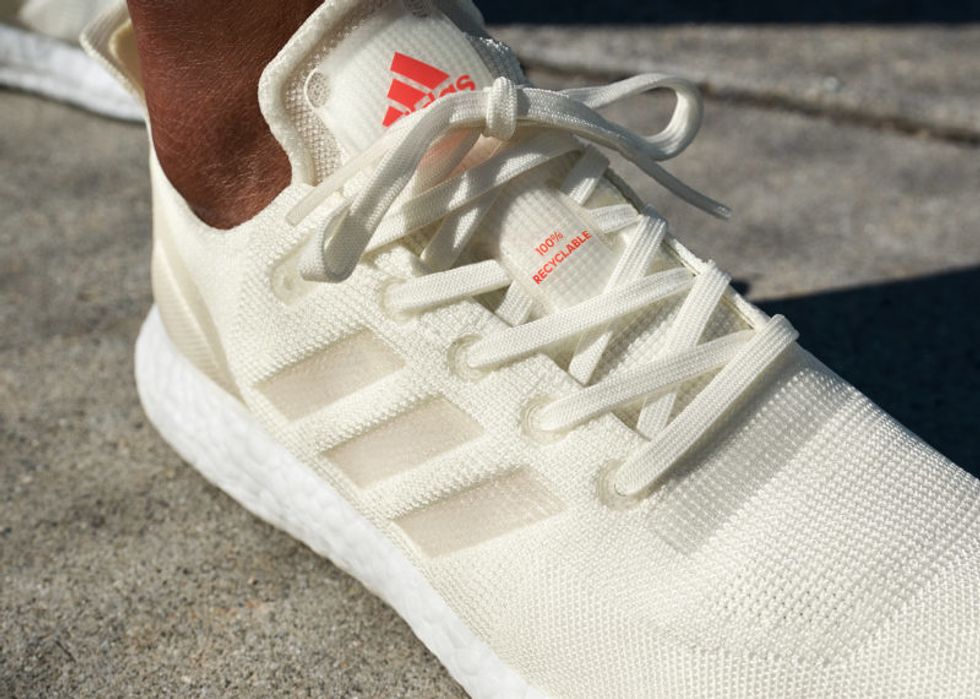Meet the Shoe That Will Never End Up in a Landfill

The adidas FUTURECRAFT.LOOP
Have you ever wondered what happens to your worn-out sneakers when you throw them away? They will likely spend the next few decades decomposing in a landfill.
"You simply take it, grind it up and make a new one. But under the surface, it's extremely technical and complex."
According to the most current government statistics, eight million tons of shoes and clothing were sent to landfills in 2015 alone. As the trashed items break down over many years, they produce toxic greenhouse gases like methane and carbon dioxide, contributing to global climate change.
The Lowdown
Sportswear manufacturer adidas was well aware of their industry's harmful environmental impact, so they set out to become part of the solution. A few years ago, they partnered with various companies to gather and reuse plastics from the ocean to make clothes and parts of shoes.
Then they wondered if they could take their vision a step further: Could they end the concept of waste entirely?
This ambition drove them to create a high-performance athletic shoe made with entirely reusable material – the new FutureCraft Loop. It's a shoe you never have to throw out.
"It's something that outwardly appears very simple," said Paul Gaudio, adidas' Global Creative Director. "You simply take it, grind it up and make a new one. I think that's super elegant and easy to understand. But under the surface, it's extremely technical and complex and it is quite literally a science project."
This project began with a group of engineers, material scientists, and designers trying to find a material that could be pliable enough to take the place of 10-12 different components normally used to make a shoe, yet durable enough to provide the support a running shoe requires. The team decided on thermoplastic polyurethane (TPU), a strong and versatile material that can be re-melted and re-molded even after it's solidified. The team worked for close to a decade on research and development.

Adidas FUTURECRAFT.LOOP
The result, Gaudio said, is an athletic shoe that doesn't compromise on quality and also won't pollute the planet. The wearer will likely notice the shoe feels different because it's welded together by heat alone.
"You feel a more direct connection [to the shoe] because you don't have the layers and glue,"he explained.
Next Up
One of the next steps will be for adidas to engage with consumers to find out the best way to get them to return their used shoes for recycling so that they can, so to say, close the loop.
"We're trying to decide what that looks like," Gaudio said. "Is it a take-back program, is it a subscription mode? Do you return it at stores? So that's the next big challenge that we're working on and that's why we've started to engage people outside the brand in that process."
The FutureCraft Loop is in beta testing with a small group, but if all goes well, the shoe may be available for purchase in early 2021. The pricing hasn't been set, but Gaudio said that the goal is to make it affordable.
"If it's something that's too exclusive or unattainable," he said, "it defeats the purpose."
Open Questions
Although TPU is a completely recyclable material, the team at adidas is working to perfect the process.
"We have a passion to apply creativity and imagination to the problems of plastic in the oceans and the plastic waste."
"Each time you recycle something there is a change – a degradation and contamination," Gaudio noted. "So if I ground the whole thing up, can I make the exact same shoe again with this exact same batch of material today? No, but we can still recycle 100 percent of it. But we're working towards being able to take the knit upper and make a new knit upper."
Gaudio hopes that other companies will follow suit, although adidas is moving to develop ownership of their solutions, including the process behind making the FutureCraft Loop.
"We have a passion to apply creativity and imagination to the problems of plastic in the oceans and the plastic waste and that's what's driving us," he said.
Thanks to safety cautions from the COVID-19 pandemic, a strain of influenza has been completely eliminated.
If you were one of the millions who masked up, washed your hands thoroughly and socially distanced, pat yourself on the back—you may have helped change the course of human history.
Scientists say that thanks to these safety precautions, which were introduced in early 2020 as a way to stop transmission of the novel COVID-19 virus, a strain of influenza has been completely eliminated. This marks the first time in human history that a virus has been wiped out through non-pharmaceutical interventions, such as vaccines.
The flu shot, explained

Influenza viruses type A and B are responsible for the majority of human illnesses and the flu season.
Centers for Disease Control
For more than a decade, flu shots have protected against two types of the influenza virus–type A and type B. While there are four different strains of influenza in existence (A, B, C, and D), only strains A, B, and C are capable of infecting humans, and only A and B cause pandemics. In other words, if you catch the flu during flu season, you’re most likely sick with flu type A or B.
Flu vaccines contain inactivated—or dead—influenza virus. These inactivated viruses can’t cause sickness in humans, but when administered as part of a vaccine, they teach a person’s immune system to recognize and kill those viruses when they’re encountered in the wild.
Each spring, a panel of experts gives a recommendation to the US Food and Drug Administration on which strains of each flu type to include in that year’s flu vaccine, depending on what surveillance data says is circulating and what they believe is likely to cause the most illness during the upcoming flu season. For the past decade, Americans have had access to vaccines that provide protection against two strains of influenza A and two lineages of influenza B, known as the Victoria lineage and the Yamagata lineage. But this year, the seasonal flu shot won’t include the Yamagata strain, because the Yamagata strain is no longer circulating among humans.
How Yamagata Disappeared

Flu surveillance data from the Global Initiative on Sharing All Influenza Data (GISAID) shows that the Yamagata lineage of flu type B has not been sequenced since April 2020.
Nature
Experts believe that the Yamagata lineage had already been in decline before the pandemic hit, likely because the strain was naturally less capable of infecting large numbers of people compared to the other strains. When the COVID-19 pandemic hit, the resulting safety precautions such as social distancing, isolating, hand-washing, and masking were enough to drive the virus into extinction completely.
Because the strain hasn’t been circulating since 2020, the FDA elected to remove the Yamagata strain from the seasonal flu vaccine. This will mark the first time since 2012 that the annual flu shot will be trivalent (three-component) rather than quadrivalent (four-component).
Should I still get the flu shot?
The flu shot will protect against fewer strains this year—but that doesn’t mean we should skip it. Influenza places a substantial health burden on the United States every year, responsible for hundreds of thousands of hospitalizations and tens of thousands of deaths. The flu shot has been shown to prevent millions of illnesses each year (more than six million during the 2022-2023 season). And while it’s still possible to catch the flu after getting the flu shot, studies show that people are far less likely to be hospitalized or die when they’re vaccinated.
Another unexpected benefit of dropping the Yamagata strain from the seasonal vaccine? This will possibly make production of the flu vaccine faster, and enable manufacturers to make more vaccines, helping countries who have a flu vaccine shortage and potentially saving millions more lives.
After his grandmother’s dementia diagnosis, one man invented a snack to keep her healthy and hydrated.
Founder Lewis Hornby and his grandmother Pat, sampling Jelly Drops—an edible gummy containing water and life-saving electrolytes.
On a visit to his grandmother’s nursing home in 2016, college student Lewis Hornby made a shocking discovery: Dehydration is a common (and dangerous) problem among seniors—especially those that are diagnosed with dementia.
Hornby’s grandmother, Pat, had always had difficulty keeping up her water intake as she got older, a common issue with seniors. As we age, our body composition changes, and we naturally hold less water than younger adults or children, so it’s easier to become dehydrated quickly if those fluids aren’t replenished. What’s more, our thirst signals diminish naturally as we age as well—meaning our body is not as good as it once was in letting us know that we need to rehydrate. This often creates a perfect storm that commonly leads to dehydration. In Pat’s case, her dehydration was so severe she nearly died.
When Lewis Hornby visited his grandmother at her nursing home afterward, he learned that dehydration especially affects people with dementia, as they often don’t feel thirst cues at all, or may not recognize how to use cups correctly. But while dementia patients often don’t remember to drink water, it seemed to Hornby that they had less problem remembering to eat, particularly candy.

Hornby wanted to create a solution for elderly people who struggled keeping their fluid intake up. He spent the next eighteen months researching and designing a solution and securing funding for his project. In 2019, Hornby won a sizable grant from the Alzheimer’s Society, a UK-based care and research charity for people with dementia and their caregivers. Together, through the charity’s Accelerator Program, they created a bite-sized, sugar-free, edible jelly drop that looked and tasted like candy. The candy, called Jelly Drops, contained 95% water and electrolytes—important minerals that are often lost during dehydration. The final product launched in 2020—and was an immediate success. The drops were able to provide extra hydration to the elderly, as well as help keep dementia patients safe, since dehydration commonly leads to confusion, hospitalization, and sometimes even death.
Not only did Jelly Drops quickly become a favorite snack among dementia patients in the UK, but they were able to provide an additional boost of hydration to hospital workers during the pandemic. In NHS coronavirus hospital wards, patients infected with the virus were regularly given Jelly Drops to keep their fluid levels normal—and staff members snacked on them as well, since long shifts and personal protective equipment (PPE) they were required to wear often left them feeling parched.
In April 2022, Jelly Drops launched in the United States. The company continues to donate 1% of its profits to help fund Alzheimer’s research.

